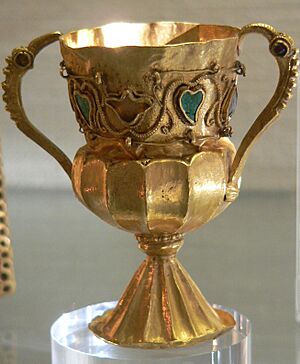Treasure of Gourdon facts for kids
The Treasure of Gourdon is a collection of valuable gold objects. These items were made around the late 400s or early 500s AD. They were likely hidden around the year 524 AD. This amazing treasure was found in 1845 near a place called Gourdon in France.

Contents
What Was Found in the Treasure?
When the treasure was discovered, it included a special cup called a chalice and a flat plate called a paten. Both were decorated with beautiful red garnets and blue turquoises. These stones were set into small sections using a technique called cloisonné.
The treasure also contained about one hundred gold coins. These coins dated from the time of Byzantine emperors like Leo I (457–474 AD) and Justin I (518–527 AD).
The chalice and paten might have been made during the early Merovingian period or late Gallo-Roman times. The Merovingian king Clovis I became a Christian in 496 AD.
Today, the Treasure of Gourdon is kept safe in the Cabinet des Médailles museum in Paris. This museum is part of the National Library of France.
The Golden Chalice
The chalice is about 7.5 centimeters (about 3 inches) tall. It stands on a cone-shaped base. It has two handles shaped like birds, but they are very simple. You can only tell they are birds by their beaks and the garnets that form their eyes.
The top part of the chalice is decorated with garnets and turquoises. These colorful stones are cut into shapes like hearts and palmettes (a design like a palm leaf). They are set using the cloisonné technique.
The shape of this chalice is similar to ancient Roman wine cups. The way it is decorated, with bird designs and the cloisonné technique, was common in art from groups often called "barbarian" at the time. This style made the chalice light and easy to carry. Similar bird designs can be seen in metalwork from the Visigoth, Lombard, and Merovingian peoples.
The Golden Paten
The rectangular paten is about 19.5 centimeters (about 7.7 inches) long and 12.5 centimeters (about 4.9 inches) wide. It is about 1.6 centimeters (about 0.6 inches) deep.
It has a border made of cloisonné garnets. In the center, there is a Christian cross also made of garnets. Each of the four corners has a design made of turquoise. The Christian cross clearly shows that these objects were used for Christian religious services.
History of the Treasure
In the 500s AD, Gourdon was home to a monastery. It is possible that the chalice and paten belonged to this monastery. The latest date found on the coins in the treasure is around 524 AD.
During the 520s, there was a war in eastern Gaul (an ancient region of Europe, mostly modern-day France). The war was fought by the four sons of King Clovis against the Burgundians. This war ended in 524 AD with the Battle of Vézeronce, where the Burgundians were defeated. The treasure may have been buried to keep it safe from this war or from a raid.
A young shepherd girl named Louise Forest found the treasure in 1845. It was hidden under a Roman tile that had a cross carved into it. The treasure was later sold at an auction in Paris on July 20, 1846. The French government bought the paten and chalice. However, the gold coins were sold separately and are no longer available for the public to see.


